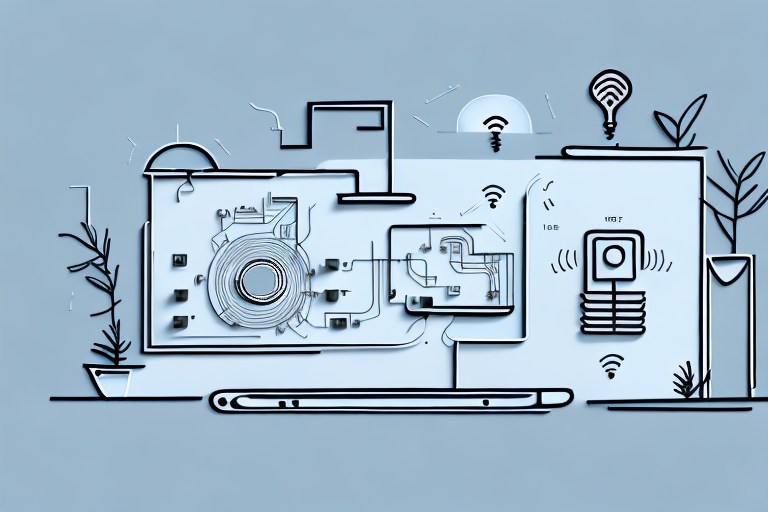In today’s rapidly advancing digital age, home automation has become a popular trend among homeowners. Controlling various aspects of your home with just a touch of a button or a simple voice command is no longer a futuristic fantasy. With the rise of smart technology, light switches have undergone a significant evolution to become an integral part of home automation systems. In this article, we will explore the latest trends in light switch design and their impact on home automation and design.
Understanding Home Automation
Before delving into the world of light switch trends, it’s important to have a solid understanding of home automation. Home automation refers to the ability to control various electronic devices and systems within your home using a centralized control system. From lighting and temperature control to security and entertainment systems, home automation allows homeowners to streamline and simplify their daily lives.
But what exactly does home automation entail? Let’s explore the basics of this innovative technology.
Light Switch Push Button
The light switch push button serves as a pivotal component in modern lighting control systems. This innovative switch design not only enhances functionality but also adds a touch of convenience to daily life. With a light switch push button, users can effortlessly activate or deactivate lighting fixtures with a simple press, eliminating the need for traditional toggle switches.
This user-friendly interface is not only aesthetically pleasing but also provides a tactile and responsive experience. Whether integrated into smart home systems or utilized in conventional setups, the light switch push button offers an efficient and reliable means of controlling illumination, catering to the evolving demands of contemporary interior design and technology integration.
The Basics of Home Automation
At its core, home automation relies on a network of interconnected devices and systems. These devices are equipped with sensors, actuators, and communication technology, allowing them to interact with each other and with the user. These interactions can range from basic on/off commands to complex sequences of actions, all aimed at enhancing comfort, convenience, and energy efficiency.
Imagine waking up in the morning and your curtains automatically open, letting in the gentle sunlight. As you step into the kitchen, the coffee machine starts brewing your favorite blend, and the aroma fills the air. All of this is made possible through home automation.
But it doesn’t stop there. Home automation can also integrate with your security system, providing you with peace of mind. With just a tap on your smartphone, you can check the live feed from your security cameras, lock or unlock doors, and even receive instant notifications if any unusual activity is detected.
Benefits of Home Automation
The advantages of home automation are numerous and varied. One of the key benefits is enhanced comfort and convenience. Imagine arriving home after a long day at work, and with a simple voice command, your lights turn on, your favorite music starts playing, and the thermostat adjusts to your preferred temperature. Home automation eliminates the need to manually operate each device, allowing for a seamless and personalized experience.
Another significant advantage of home automation is increased energy efficiency. With the ability to monitor and control energy usage, homeowners can optimize their energy consumption and reduce utility bills. For example, smart lighting systems can automatically adjust brightness levels based on occupancy or natural daylight, minimizing electricity waste.
Moreover, home automation can also contribute to a safer living environment. Integrated security systems can include features such as motion sensors, door/window sensors, and smoke detectors, all of which can be monitored and controlled remotely. In case of an emergency, you can receive immediate alerts and take appropriate action, even if you’re away from home.
Additionally, home automation can provide valuable insights into your household habits and patterns. By analyzing data collected from various sensors and devices, you can gain a better understanding of your energy usage, daily routines, and even sleep patterns. This information can help you make informed decisions to further optimize your home’s efficiency and overall well-being.

As technology continues to advance, the possibilities of home automation are expanding. From voice-controlled virtual assistants to smart appliances that can reorder groceries, the future of home automation is exciting and full of potential.
The Evolution of Light Switches
Light switches are an essential component of any home, and their design and functionality have come a long way over the years. From traditional wall switches to sleek touchscreens and voice-activated controls, light switches have embraced modern technology to offer more convenience and style.
But how did we get here? Let’s take a closer look at the evolution of light switches and the exciting advancements that have shaped their design.
Traditional Light Switches vs. Modern Alternatives
Traditional light switches have been the standard for decades, with their simple on/off functionality. However, modern alternatives have emerged to cater to the demands of home automation. These alternatives include smart switches, touchless switches, and motion sensor switches, among others.
Smart light switches, for example, offer advanced features such as programmable schedules, remote access, and integration with voice assistants like Amazon Alexa or Google Assistant. Imagine being able to control your lights from anywhere in the world with just a few taps on your smartphone or a simple voice command.
Touchless switches, on the other hand, utilize infrared sensors to detect hand movements, allowing for a contact-free operation. This technology is not only convenient but also hygienic, especially in environments where cleanliness is a top priority.
Motion sensor switches automatically turn on lights when motion is detected, ideal for hallways or rooms that require hands-free illumination. These switches not only provide convenience but also help save energy by ensuring that lights are only on when needed. You can also read about A Closer Look at Perth’s Property Landscape with a Buyers Agent.
The Role of Technology in Light Switch Design
The integration of technology has revolutionized light switch design, making them more than just functional devices. With the advent of smartphones and smart home hubs, light switches can now be controlled remotely through dedicated mobile apps or voice commands.
Imagine arriving home on a dark winter evening and being able to turn on the lights before even stepping inside. With smart light switches, this is now a reality. You can create custom schedules to have your lights automatically turn on and off at specific times, giving the illusion that someone is home even when you’re away.
Additionally, advancements in capacitive touch technology have enabled the creation of sleek and minimalist touchscreens, replacing traditional buttons and switches. These touchscreens not only add a modern and sophisticated touch to your home decor but also provide a more intuitive and user-friendly interface.
Furthermore, the integration of light switches with voice assistants has taken convenience to a whole new level. With just a simple voice command, you can dim the lights, change their color, or even create different lighting scenes to set the mood for any occasion.
In conclusion, the evolution of light switches has been driven by the desire for convenience, energy efficiency, and style. From traditional switches to smart switches, touchless switches, and motion sensor switches, the options available today are vast and exciting. With technology continuing to advance at a rapid pace, we can only imagine what the future holds for light switch design.
Current Trends in Light Switch Design
When it comes to design trends, light switches have seen some noteworthy developments in recent years. Two prominent trends dominating the market are smart light switches and touchless light switches.
Smart Light Switches
Smart light switches offer a wide range of features that go beyond simple on/off control. These switches can be integrated with home automation platforms, allowing for seamless control over lighting, energy usage, and even ambiance settings.
Imagine coming home after a long day at work and being able to turn on the lights in your living room with just a voice command. With smart light switches, homeowners can create customized lighting scenes, set timers or schedules, and receive real-time energy consumption data. This level of control not only enhances convenience but also helps in reducing energy wastage and lowering electricity bills.
Moreover, smart light switches can be synchronized with other smart devices in the house. For instance, you can program your lights to turn on automatically when your smart doorbell detects motion, providing an added layer of security.
Touchless Light Switches
Touchless light switches have gained popularity due to their hygienic and convenient operation. Utilizing infrared technology, touchless switches detect hand movements, eliminating the need for physical contact.
Picture yourself in the kitchen, preparing a delicious meal, and your hands are covered in flour. With a touchless light switch, you can simply wave your hand in front of the switch, and the lights will turn on or off without you having to touch anything. This not only prevents the spread of germs but also saves you from having to clean the light switch regularly.
Touchless switches are also a great addition to bathrooms, where you often have wet hands. Instead of fumbling for a switch with damp fingers, you can effortlessly control the lights with a simple hand gesture. This technology is particularly useful for children and elderly individuals who may have difficulty reaching or operating traditional switches.
Furthermore, touchless light switches can be programmed to adjust the brightness of the lights based on the time of day or the amount of natural light in the room. This feature helps create a comfortable and energy-efficient environment, as the lights automatically adapt to the surrounding conditions.
In conclusion, the current trends in light switch design are focused on enhancing convenience, energy efficiency, and hygiene. Smart light switches offer advanced control options and integration with home automation systems, while touchless switches provide a hands-free and germ-free solution. As technology continues to advance, we can expect further innovations in light switch design that will revolutionize the way we interact with our lighting systems.
Integrating Light Switches into Home Automation Systems
For homeowners seeking a seamless home automation experience, integrating light switches into existing systems is essential. Compatibility and the integration process are key considerations when selecting light switches for your home.
Compatibility with Home Automation Systems
Before purchasing light switches, it’s crucial to ensure their compatibility with your preferred home automation system. This compatibility allows for smooth communication and control between devices, ensuring a unified and interconnected smart home ecosystem.
The Process of Integration
The process of integrating light switches into home automation systems can vary depending on the chosen system and the switches themselves. However, most modern smart switches are designed to be easily integrated using wireless protocols such as Wi-Fi, Zigbee, or Z-Wave. This wireless connectivity enables seamless communication with other smart devices and the centralized control system.
Future Predictions for Light Switch Technology
Looking ahead, light switch technology is poised to witness further advancements and innovations. Emerging technologies and trends are expected to shape the future of light switch design and functionality.
Potential Developments in Light Switch Design
In the near future, we can expect light switches to become even smarter and more intuitive. This could include features such as built-in sensors to detect room occupancy, gesture recognition for advanced controls, and adaptive lighting based on individual preferences and circadian rhythms.
The Impact of Emerging Technologies on Home Automation
As emerging technologies like artificial intelligence, machine learning, and augmented reality continue to evolve, the possibilities for home automation are expanding. These technologies have the potential to enhance the capabilities of light switches and home automation systems, resulting in smarter and more personalized experiences for homeowners.
In conclusion, the world of light switches has evolved significantly with the advent of home automation. From basic on/off functionality to smart switches and touchless controls, light switches are no longer just mundane devices. They have become integral components of sophisticated home automation systems, offering convenience, energy efficiency, and aesthetic appeal. As technology continues to advance, the future of light switch design holds exciting opportunities for transforming the way we interact with our homes.



